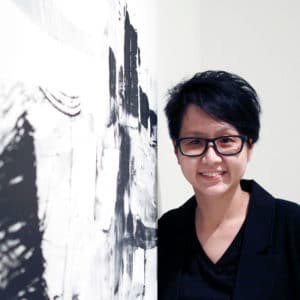Three Minutes with Kai

Born in Singapore 1976, Shih Yun is a full-time artist and Director of INSTINC, an independent artist-run space. With an ink-based, East-meets-West aesthetic—influenced by the tutelage of eminent painter Chua Ek Kay—she has been known to reinterpret the very act of ink painting with striking results. Her experimentations of fusing the traditional form with contemporary mediums like new media or performance art has garnered much acclaim, including a commission by the Singapore Art Museum, and winning the Sovereign Asian Art Prize People’s Choice Award in 2012.
Pictured: Inkpulse #3, 2017, Yeo Shih Yun. Chinese ink on paper.
1) Inkpulse #3 has such a remarkable intensity and boldness to it, with a spontaneous unpremeditated quality. How long does it take you to create a painting like that? Do you have to prepare yourself before a painting or is it random and unplanned?
The process of painting is fast but the preparation and experience that adds up to the point takes many years of painting (I’ve been painting since 1999). Just like a musician who plays a piece on stage. I will prepare all my ‘instruments’ , ink and papers on the floor and turn on my favorite piece of music and then wait for the ‘moment’ to execute the works. My mind is only focus on the strokes and not the contents of the works.

An excerpt from Book IV of Music of Changes in John Cage’s calligraphic score. Source
2) You’ve said that the present moment is a “special time of focused attention and heightened awareness”. Do you practice any techniques to help your painting such as meditation, tai-chi?
No, I dont practice any of such techniques. I like music though. One of my favorite is John Cage’s music due to its ‘randomness’ quality of his prepared piano.
Yeo and her mentor, renowned painter Chua Ek Kay
3) You met renowned ink painter Chua Ek Kay during your time in Lasalle College of the Arts. What was that experience like, and what was the most valuable lesson from him?
Yes, Mr Chua is a very patient teacher and I am so fortunate to be one of his many students. I dont think there is one most valuable lesson as I feel that each and every of his lesson is valuable. I enjoyed learning to paint bamboos, birds and flowers. You cannot paint two exactly the same bamboo paintings, every stroke, light and darkness of the ink is different, that is the beauty of Chinese ink—infinite possibilities.
4) Over the course of your career, you’ve had 10 solo shows and participated in 86 group exhibitions. Do any stand out for you, and why?
I like collaborations and cultural exchange so there are three exhibitions that I love most. One was at the Esplanade – Theatres by the Bay with 3 other ink painters: Quek Kiat Sing, Oh Chai Hoo and Tay Bay Chiang. We were inside the space for 7 days to create a site-specific collaborative installation. It was really fun to see them paint and to interact with them! Another one was Project6581 with 4 Singapore and 4 Japan artists. The third would be my solo exhibition Choreographed Collisions, at Galerie Steph – featuring my collaborations with the toy robots.

Conversations With Trees #19, Yeo Shih Yun, 2011
5) Trees have often been the subject of many Chinese ink paintings. Yet in Conversations with Trees, you make the tree the artist instead. What did it feel like to let go of that authority, and leave it to the invisible hand of nature?
Letting go of control is only the first step of the long process. After this initial step of trees painting, there are many processes which requires me to regain control. So it’s great to be able to use of the trees to capture some honest and beautiful marks that no human hand could produce.

Conversation With Trees #5, Yeo Shih Yun, 2011
6) These ‘acts of nature’ create a new kind of abstract, artistic language, and yet ironically end up looking remarkably similar to a traditional Chinese ink painting. Why do you think that is? Is there something in common with nature and aesthetics?
Yes, the most natural things in the world is the most beautiful. Nature and all God’s creation is stunning like oceans, sunsets, mountains, waterfalls, ice glaciers…

Against The Sky, Yeo Shih Yun, 2013
7) You had the inspiration to create “Norway Series” on an artist residency in Bergen, Norway. How important do you think residencies are to artists, based on your own experiences?
Super important! Artists need time on their won away from distractions and comfort zone so that they can find their inner artist voice.
8) Is this why you started INSTINC? Can you tell us more about it: how does it function as an artist residency?
I started INSTINC due to lack of affordable spaces to exhibit and also as someone from San Francisco Art Institute I did not have any artist friends. INSTINC artist residency program only began in 2009 after my first residency in 2008.
9) If you could turn back time, would you have done anything differently?
I don’t think I will do things different. Everything happens for a reason and every stage of the way is important. Like I am happy that I have a degree in Marketing from Business School NUS and skills of graphics design from Lasalle.
10) A piece of advice for budding painters?
Follow your heart and never give up!
